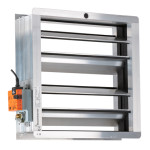Ventilation System Dampers

ANSI/IIAR 2 Addendum B §13.3.3.4 requires that “If motorized dampers are utilized they shall be of the power to close and spring to open type.”
The version of IIAR 2 most recently released for public review states: “Motorized louvers or dampers, where utilized, shall fail to the open position upon loss of power.”
Would either (or both) of these code references restrict the use of gravity backdraft dampers since they “fail” in the “closed position“?
It is worth mentioning that 2012 Uniform Mechanical Code §1108.9 requires the following:
Makeup air intakes to replace the exhaust air shall be provided to the refrigeration machinery room directly from outside the building. Intakes shall be located as required by other sections of the code and fitted with backdraft dampers or other approved flow-control means to prevent reverse flow. Distribution of makeup air shall be arranged to provide thorough mixing within the refrigeration machinery room to prevent short circuiting of the makeup air directly to the exhaust.
Answer:
Both IIAR versions, although worded differently, require motorized dampers to fail open if a power outage were to occur.
We are working to have the UMC refer to IIAR 2 for ammonia refrigeration systems. Commenters do not want to get restricted to stating backdraft dampers [are always required] (which many sites do not have or do not want to be forced to have them for future systems) and only wanted to state the requirements for motorized dampers that use power for their operation. The consensus is that they want the dampers to open if a power outage occurs to assure that if a leak were to occur, it would not be trapped and escalate above the 25% LFL (40,000 ppm = 25% of 160,000 ppm which is the 16% LFL).
It is figured that the emergency ventilation will be on a separate power circuit from the equipment (as well as the detection and alarms) which will overcome the reverse flow concern for dampers that have failed opened.

Leave a Reply